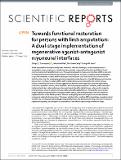| dc.contributor.author | Srinivasan, Shriya S | |
| dc.contributor.author | Diaz, Maurizio | |
| dc.contributor.author | Carty, Matthew | |
| dc.contributor.author | Herr, Hugh M | |
| dc.date.accessioned | 2021-10-27T20:10:56Z | |
| dc.date.available | 2021-10-27T20:10:56Z | |
| dc.date.issued | 2019 | |
| dc.identifier.uri | https://hdl.handle.net/1721.1/135147 | |
| dc.description.abstract | © 2019, The Author(s). While amputation has traditionally been viewed as a failure of therapy, recent developments in amputation surgery and neural interfacing demonstrate improved functionality and bidirectional communication with prosthetic devices. The agonist antagonist myoneural interface (AMI) is one such bi-directional neural communication model comprised of two muscles, an agonist and an antagonist, surgically connected in series within the amputated residuum such that contraction of one muscle stretches the other. By preserving agonist-antagonist muscle dynamics, the AMI allows proprioceptive signals from mechanoreceptors within both muscles to be communicated to the central nervous system. Preliminary human evidence suggests that AMIs have the capacity to provide high fidelity control of a prosthetic device, force feedback, and natural proprioception. However, AMIs have been implemented only in planned amputations and require healthy distal tissues, whereas the majority of amputations occur in patients who do not have healthy distal tissues. Through the use of a dual-stage surgical procedure which leverages existent tissues, this study proposes a revision model for implementation of the AMI in patients who are undergoing traumatic amputation or have already undergone a standard amputation. This paper validates the resulting AMI’s physiology, revealing robust viability and mechanical and electrophysiological function. We demonstrate the presence of H-waves in regenerative grafts, indicating the incorporation of the AMI into physiological reflexive loops. | |
| dc.language.iso | en | |
| dc.publisher | Springer Nature | |
| dc.relation.isversionof | 10.1038/S41598-018-38096-Z | |
| dc.rights | Creative Commons Attribution 4.0 International license | |
| dc.rights.uri | https://creativecommons.org/licenses/by/4.0/ | |
| dc.source | Scientific Reports | |
| dc.title | Towards functional restoration for persons with limb amputation: A dual-stage implementation of regenerative agonist-antagonist myoneural interfaces | |
| dc.type | Article | |
| dc.contributor.department | Harvard University--MIT Division of Health Sciences and Technology | |
| dc.contributor.department | Massachusetts Institute of Technology. Center for Extreme Bionics | |
| dc.contributor.department | Massachusetts Institute of Technology. Media Laboratory | |
| dc.relation.journal | Scientific Reports | |
| dc.eprint.version | Final published version | |
| dc.type.uri | http://purl.org/eprint/type/JournalArticle | |
| eprint.status | http://purl.org/eprint/status/PeerReviewed | |
| dc.date.updated | 2019-06-18T18:16:34Z | |
| dspace.orderedauthors | Srinivasan, SS; Diaz, M; Carty, M; Herr, HM | |
| dspace.date.submission | 2019-06-18T18:16:36Z | |
| mit.journal.volume | 9 | |
| mit.journal.issue | 1 | |
| mit.metadata.status | Authority Work and Publication Information Needed | |
